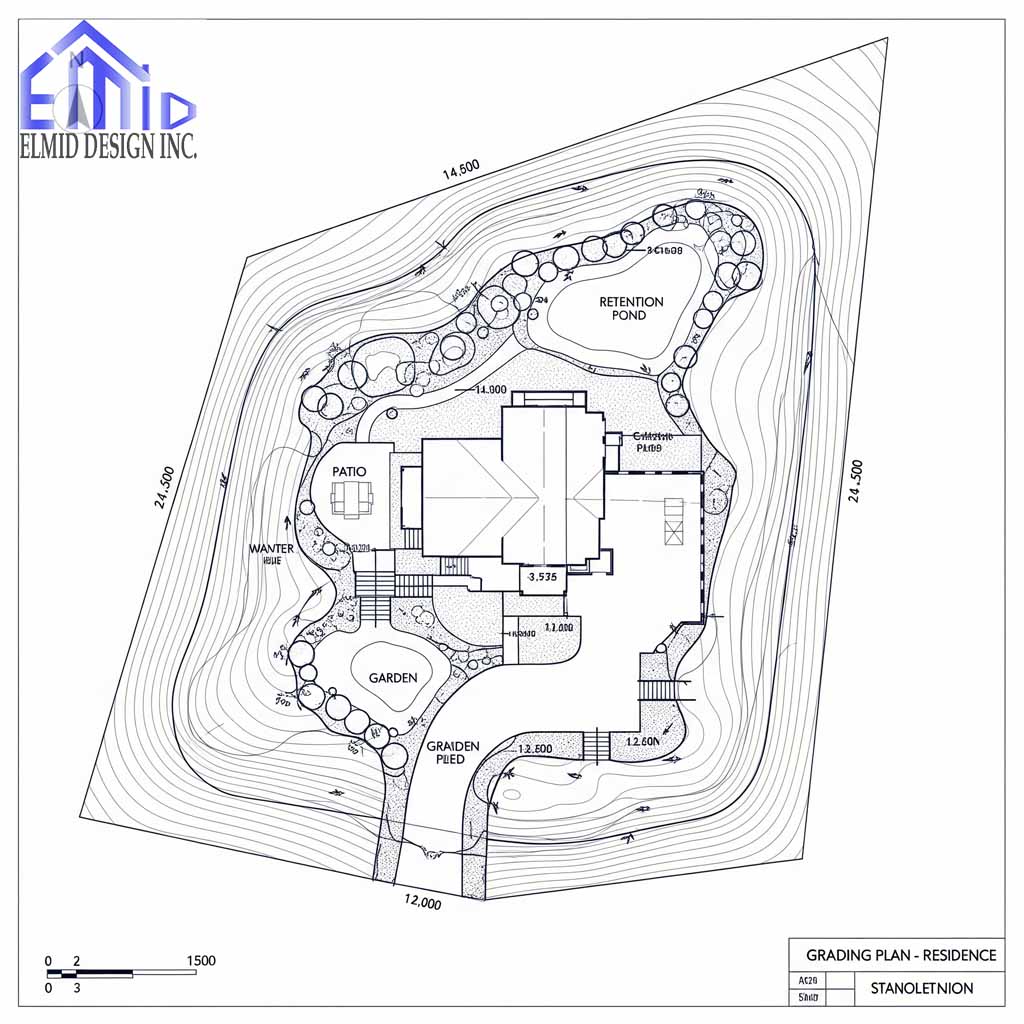A grading plan Schomburg project must meet specific drainage, engineering, and municipal standards before gaining permit approval in King Township. As Schomburg grows with custom homes, additions, and rural developments, accurate grading design plays a crucial role in protecting properties and maintaining the area’s character. These plans ensure surface water drains safely from structures while meeting slope and runoff controls defined by local bylaws and conservation regulations. Whether you’re building on farmland, infill lots, or near protected landscapes, a professional grading plan is required for compliance, safety, and long-term value.
Understanding a Grading Plan Schomburg Project
A grading plan Schomburg application includes proposed changes to the land’s elevation, slope direction, and surface drainage. It uses precise topographic data to show how runoff will move across the site. The plan must guide water away from the foundation, protect neighboring properties, and avoid runoff into nearby creeks or sensitive zones. In King Township, grading plans also consider lot-specific constraints such as driveways, setbacks, and easements. Engineers tailor each plan to reflect actual ground conditions. When correctly prepared, the grading plan becomes an essential document in both permit review and post-construction inspection.
Why You Need a Grading Plan in Schomburg
Without a proper grading plan, most development projects in Schomburg will not receive permit approval. The Township of King enforces grading design as a condition for issuing permits related to new builds, additions, walkouts, retaining walls, pools, and site regrading. These plans reduce risk of property flooding, erosion, and disputes between neighbors over drainage direction. They also help preserve Schomburg’s rural charm and protect downstream systems. As more land in the area is developed, accurate site grading ensures each project integrates responsibly with its environment. Grading design is both a legal requirement and a tool for long-term property protection.
Regulations Governing Grading Plan Schomburg Requirements
Grading plans in Schomburg must comply with several regulatory layers. The Ontario Building Code sets minimum drainage standards to avoid foundation damage. King Township enforces its own grading and drainage bylaw, requiring positive slope away from structures and control of surface runoff. Many lots fall under the oversight of conservation authorities, especially if they border wetlands, woodlots, or lowlands. In these cases, grading plans must avoid disrupting natural flow or encroaching on regulated zones. Engineers must account for these rules from the start to avoid approval delays or the need for redesign during the review process.
Topographic Surveys for Schomburg Lot Design
Before a grading plan can be created, a topographic survey must be conducted to map the current conditions of the land. This includes elevations, visible features, vegetation, structures, and existing drainage paths. Surveyors collect elevation points using advanced tools like GPS and robotic total stations. These measurements form the base layer for all grading calculations. In Schomburg’s mix of rural and semi-urban sites, accuracy is critical to avoid slope errors or mismatched drainage design. Engineers rely on this survey data to calculate finished grades, swales, and contours that comply with code and reflect realistic field conditions.
Submitting Your Grading Plan to King Township
When submitting a grading plan in Schomberg, property owners must include it with their permit application package. A licensed professional engineer seals the plan and clearly identifies all proposed and existing grades, drainage directions, structures, and access points. The Township of King Development Engineering team reviews these documents to confirm compliance with municipal grading standards. If they find missing details or non-compliance with local bylaws, they send the plan back for revision. Submitting a clear, complete, and properly formatted grading plan helps speed up the approval process and prevents costly delays.

Designing Proper Slopes in a Grading Plan Schomburg Project
Slope design is one of the most important elements in any grading plan for Schomburg. Engineers must ensure that ground surfaces slope away from the foundation at an acceptable grade to prevent water accumulation. Each portion of the lot, from walkways to lawn areas, requires its own slope calculation based on usage, surface type, and drainage target. The Township of King provides strict guidelines for minimum and maximum slopes to control runoff. In rural areas or lots with limited access to municipal storm services, engineers must find balance between effective drainage and site usability. Proper slope design protects both the property and the surrounding environment.
Addressing Drainage and Runoff in Schomburg
Every grading plan in Schomburg must include a drainage strategy that meets local requirements and reflects on-the-ground realities. Drainage arrows show the flow direction of surface water, while proposed grades shape how that water moves. Engineers consider the full site layout to ensure that runoff does not flow toward neighboring lots or public roads. In some areas of Schomburg, limited infrastructure places greater importance on natural infiltration or swales to manage water volume. Drainage must also factor in structures like garages, patios, and outbuildings to avoid pooling around foundations. A clear, functional drainage design is critical to project approval.
Environmental Impact and Conservation Guidelines
Schomburg’s natural features include woodlots, wetlands, and rolling terrain, which require extra care in grading design. Conservation authorities regulate much of this land, requiring engineers to follow rules that protect local ecosystems. These rules may restrict how much land can be regraded, especially near streams or protected zones. In these situations, the grading plan must maintain the natural water table, avoid erosion, and preserve vegetation buffers. Engineers sometimes include low-impact design features such as infiltration zones or vegetated swales. Designing to protect the environment helps move the plan through approvals and supports the community’s long-term ecological goals.
Grading Plan Review and Inspection Expectations
After submitting a grading plan, King Township’s Development Engineering staff reviews it for technical accuracy, bylaw compliance, and completeness. The reviewer confirms that slopes meet municipal standards, drainage flows in the correct direction, and no runoff will affect surrounding properties. If the plan does not meet requirements, the reviewer provides comments and instructs the applicant to revise and resubmit it. During construction, inspectors verify that on-site grading matches the approved design. They check slope measurements, swale placement, and elevations around the building. Final certification requires the finished grade to align closely with the proposed plan. Maintaining proper inspection coordination helps keep the project moving forward without delays.
Coordination Between Builder, Surveyor, and Engineer
Effective grading in Schomburg requires close coordination between multiple professionals. The surveyor provides the topographic data needed to begin design. The engineer uses this data to create a grading plan that reflects both regulatory and site-specific requirements. The builder must then follow that plan during site preparation and construction. Regular communication between these professionals ensures grading remains consistent with the approved drawings. If issues arise during excavation, the engineer may need to revise the plan to fit actual conditions. Projects succeed when all parties remain aligned from initial design to final inspection and certification.
Final Grading Certification in Schomburg Projects
After construction is complete, the Township of King requires a final grading certification to close the permit file. A licensed engineer must return to the site and verify that the actual grades match the approved grading plan. This inspection checks critical elevations, swale locations, slope directions, and site drainage conditions. If the grading does not match the plan, adjustments must be made before certification is issued. The final grading certificate must be submitted with updated drawings and a signed letter of compliance. Without this document, the municipality will not issue final approvals or occupancy clearance, delaying project closure.
Maintaining Approved Grading After Completion
After receiving final certification, property owners take full responsibility for maintaining the approved site grading. Any landscape changes, hardscaping, or excavation that alters the original drainage design can lead to issues. If owners cause runoff to flow toward adjacent properties or create drainage blockages, the municipality may step in. In Schomberg, owners must actively maintain all drainage features shown on the approved plan. They must keep swales clear, ensure slopes continue to direct water correctly, and fix erosion problems as soon as they appear. Maintaining grading integrity protects property value, site safety, and legal compliance over time.
Grading Plan Costs in Schomburg
The cost of preparing a grading plan in Schomburg depends on project size, complexity, and site conditions. Small residential infill projects typically cost less, while large rural properties or steep lots demand more design effort and engineering time. Additional costs may come from topographic surveys, conservation authority applications, or plan revisions during the approval process. Property owners should also consider the value of getting the plan right the first time. Incomplete or low-quality grading plans often lead to rejections, delays, and added engineering fees. Investing in a well-prepared, accurate grading plan reduces risk and supports smooth project execution.
Timeline Expectations for Grading Plan Completion
Timelines for grading plan development vary based on site conditions and document readiness. For a typical residential lot in Schomburg, a plan may take one to two weeks after receiving topographic survey data. If the site involves conservation review or complex terrain, the process could extend further. Additional time is often required for municipal review, especially during busy building seasons. Applicants who submit complete and professionally prepared plans usually experience faster turnaround. Coordination between the surveyor, engineer, and property owner ensures the schedule stays on track. Early planning and proactive communication reduce the risk of delays.
Elmid Design Inc: Trusted Grading Experts in Schomburg
Elmid Design Inc. provides professional engineering services for grading plans in Schomburg and the wider King Township region. With a Certificate of Authorization from Professional Engineers Ontario, the firm is qualified to produce sealed grading plans for permit approval. Elmid Design Inc. works closely with surveyors, municipal reviewers, and property owners to ensure each plan is compliant, buildable, and accurate. Their experience in Schomburg’s rural and infill contexts allows them to navigate conservation requirements and local drainage constraints. Clients trust their knowledge, responsiveness, and consistent ability to deliver plans that pass review without costly revisions.
Grading Plans for Unique or Irregular Lot Shapes
Grading a non-standard lot in Schomburg requires careful design because irregular shapes can affect water flow and limit space for proper slopes. These lots may have narrow setbacks, odd building footprints, or multiple elevation changes. Engineers must calculate slopes that function within tight boundaries while still meeting the township’s drainage and bylaw standards. Custom contours and alternative drainage features often become necessary to manage runoff properly. In these cases, standard grading templates do not work, so each element must be engineered to fit the unique terrain. A successful design balances compliance, practicality, and protection of adjacent properties.
Infill Development and Tight Site Grading
Infill lots in Schomburg often sit between established homes and must blend into existing grading without disrupting nearby drainage. Engineers designing these sites must evaluate how water flows from the new structure toward public streets, rear yards, or swales that connect to older systems. The plan must avoid sending runoff onto neighboring properties or creating low points where water can collect. Because access may be limited, site staging and construction grading also become key considerations. A clear and well-structured grading plan helps both builders and inspectors manage the build without causing conflict or costly rework.
Heritage Zone Grading Constraints
Parts of Schomburg fall within heritage or character preservation zones where new construction must fit the existing streetscape. Grading in these areas requires even more sensitivity to visual consistency and legacy drainage conditions. Engineers must match elevation transitions between the proposed development and surrounding properties while ensuring water continues to drain correctly. Sudden changes in grade can harm the historical look of a neighborhood or trigger drainage concerns among long-time residents. In these zones, township planners may request additional documentation or design modifications to meet aesthetic and functional goals. Proper grading preserves both the heritage value and technical soundness.
Integrating Stormwater Techniques into Grading Design
Modern grading plans in Schomburg increasingly incorporate low-impact development techniques to manage stormwater on-site. These strategies reduce dependence on storm sewers and prevent overloading natural drainage systems. Engineers may integrate features like shallow infiltration trenches, permeable walkways, or vegetated swales into the grading layout. These elements slow down runoff, improve water quality, and reduce erosion risk. Including stormwater management in the grading plan shows regulators that the design meets environmental objectives. It also positions the development as forward-thinking and resilient to changing weather conditions. Proactive integration of these solutions enhances the value and sustainability of the property.
FAQs About Grading Plan Schomburg Projects
When is a grading plan required in Schomburg?
A grading plan is required for most developments, including new homes, additions, pools, retaining walls, and any regrading that changes drainage patterns.
Who is authorized to prepare grading plans in Ontario?
Only licensed professional engineers or Ontario land surveyors with proper certifications can prepare and seal grading plans for submission.
What is included in a Schomburg grading plan?
The plan includes existing and proposed elevations, drainage flow directions, swales, contours, and surface features affecting runoff or slope stability.
How long does it take to get a grading plan approved?
Approval timelines vary, but a complete and compliant plan usually moves through the process in one to three weeks, depending on site complexity.
What happens if grading changes after construction?
Unapproved grading changes can cause drainage issues and may violate the approved permit. The municipality may require corrective action or re-certification.
Does Schomburg have conservation authority involvement?
Yes, properties near streams, wetlands, or woodlots may require review by a conservation authority, which may add conditions or restrictions to the grading plan.

Elmid Design Inc: Schomburg’s Leading Grading Plan Specialists
Elmid Design Inc. is a licensed engineering firm with a Certificate of Authorization from Professional Engineers Ontario, offering expert grading plan services across Schomburg and King Township. With deep knowledge of local bylaws, conservation authority regulations, and rural site conditions, the firm delivers precise, permit-ready designs for residential and commercial projects. Their team works closely with surveyors, builders, and municipal staff to ensure every grading plan meets technical standards while supporting smooth approvals. Elmid Design Inc. is trusted for accurate, efficient, and compliant engineering solutions tailored to Schomburg’s evolving development needs.
Geographic Locations That We Service:
Our Licensed Professional Engineers specializing in Engineered Site Grading Plans offer the best-engineered site grading plan, lot grading and erosion plan, and drainage plan to obtain site plan approval and building permits in Ontario, including a wide range of municipalities. Each area boasts unique features and requirements, making our tailored approach essential for success.
Toronto and Surrounding Areas
In the vibrant heart of Ontario, we service Toronto (City of Toronto) and surrounding areas. Additionally, we cover Oshawa (City of Oshawa), Pickering (City of Pickering), and Clarington (Municipality of Clarington). Furthermore, our expertise extends to Ajax (Town of Ajax), Whitby (Town of Whitby), Brock (Township of Brock), Scugog (Township of Scugog), and Uxbridge (Township of Uxbridge).
Halton Region
Moving to the Halton Region, our services encompass Burlington (City of Burlington) and Halton Hills (Town of Halton Hills). Also included are Milton (Town of Milton) and Oakville (Town of Oakville).
Peel Region
In the Peel Region, we provide services in Brampton (City of Brampton), Mississauga (City of Mississauga), and Caledon (Town of Caledon).
York Region
Our services in the York Region cover Vaughan (City of Vaughan), Aurora (Town of Aurora), and East Gwillimbury (Town of East Gwillimbury). We also cater to Georgina (Town of Georgina), Markham (City of Markham), Newmarket (Town of Newmarket), Richmond Hill (City of Richmond Hill), Whitchurch-Stouffville (Town of Whitchurch-Stouffville), King (Township of King), and Bradford-West Gwillimbury (Town of Bradford-West Gwillimbury). Each municipality here offers a distinct setting, requiring our specialized approach.
Other Southern Ontario Cities and Towns
We also serve many other cities and towns in Southern Ontario. These include Hamilton (City of Hamilton), St. Catharines (City of St. Catharines), Niagara on the Lake (Town of Niagara on the Lake), Brant (County of Brant), Cambridge (City of Cambridge), Kitchener (City of Kitchener), Waterloo (City of Waterloo), and Woodstock (City of Woodstock). Furthermore, we operate in Guelph (City of Guelph), Centre Wellington (Township of Centre Wellington), Shelburne (Town of Shelburne), Orangeville (Town of Orangeville), New Tecumseth (Town of New Tecumseth), Essa (Town of Essa), Collingwood (Town of Collingwood), Wasaga Beach (Town of Wasaga Beach), Barrie (City of Barrie), Midland (Town of Midland), Orillia (City of Orillia), Ramara (Town of Ramara), Minden Hills (Town of Minden Hills), North Kawartha (Town of North Kawartha), Kawartha Lakes (City of Kawartha Lakes), Peterborough (City of Peterborough), Selwyn (Town of Selwyn), and Brighton (Municipality of Brighton).




